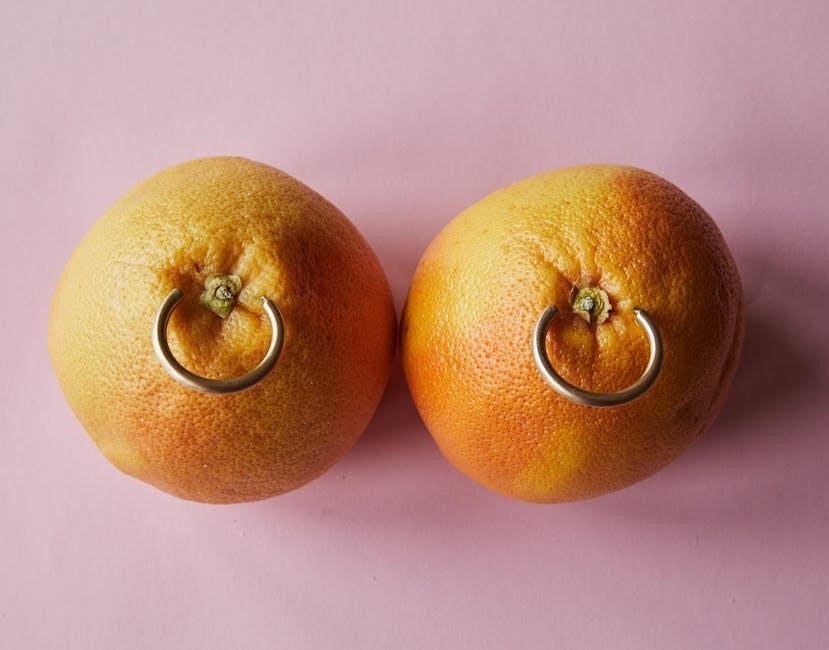Nipple piercings have become increasingly popular for their aesthetic appeal and personal expression. They come in various styles‚ including single or double piercings‚ and can be customized with different jewelry types. The size of the jewelry‚ such as the gauge and length‚ plays a crucial role in comfort and appearance. Understanding proper sizing is essential for a seamless experience‚ ensuring both functionality and visual appeal. This guide will help you navigate the world of nipple piercings with confidence.

Understanding Nipple Piercing Measurements
When it comes to nipple piercings‚ understanding the correct measurements is crucial for both comfort and aesthetics. The most common measurement to consider is the gauge‚ which refers to the thickness of the jewelry. The standard gauge for nipple piercings is typically 14G (1.6mm)‚ but sizes can range from 12G (2mm) to 16G (1.2mm)‚ depending on personal preference and anatomy. Thicker gauges (12G) provide a bolder look‚ while thinner gauges (16G) are more discreet.
In addition to gauge‚ the length and diameter of the jewelry are equally important. The barbell or ring must be long enough to accommodate swelling during the healing process but not so long that it causes irritation. A common recommendation is to start with a slightly longer piece and adjust as needed once the piercing is fully healed. For nipple bars‚ the length typically ranges from 11mm to 19mm‚ with 14mm being the most common starting point.
Choosing the right size also depends on the shape of your nipple and the type of jewelry you prefer. For example‚ individuals with smaller nipples may find shorter barbells more flattering‚ while those with larger nipples might opt for longer options. It’s important to communicate with your piercer to ensure the jewelry fits comfortably and aligns with your body’s natural proportions.
Measuring for nipple piercings can be tricky‚ as the size may vary slightly from one nipple to the other. Professionals often use specialized tools to determine the best fit‚ taking into account the nipple’s height‚ width‚ and overall shape. DIY measurements are not recommended‚ as improper sizing can lead to discomfort or prolong the healing process.

Choosing the Right Jewelry Size
Selecting the appropriate jewelry size for a nipple piercing is a critical step that ensures comfort‚ proper healing‚ and aesthetic appeal. The right size not only enhances the appearance of the piercing but also prevents complications such as irritation or migration. When choosing jewelry‚ it’s important to consider the gauge‚ length‚ and diameter‚ as these measurements directly impact both functionality and visual appeal.
The gauge refers to the thickness of the jewelry‚ with lower numbers indicating thicker pieces. For nipple piercings‚ the standard gauge is typically 14G (1.6mm)‚ but sizes can range from 12G (2mm) to 16G (1.2mm). Thicker gauges provide a more robust look‚ while thinner gauges are less noticeable. The choice often depends on personal preference and the size of the nipple. For example‚ smaller nipples may look better with thinner gauges‚ while larger nipples can accommodate thicker ones without appearing disproportionate.
The length of the jewelry is another key factor. Initially‚ a slightly longer barbell or ring is recommended to allow for swelling during the healing process. A common starting length is 14mm‚ but this can vary based on individual anatomy. Once the piercing is fully healed‚ the jewelry can be downsized to a snugger fit for comfort and aesthetics. It’s important to avoid jewelry that is too tight‚ as this can cause discomfort or hinder the healing process.
In addition to gauge and length‚ the diameter of circular jewelry‚ such as rings‚ should be considered. A diameter that is too small may cause the jewelry to sit too tightly‚ while a diameter that is too large may look unproportionate. A balanced diameter ensures the jewelry rests comfortably on the nipple without causing strain.
Ultimately‚ the right jewelry size is a balance of personal style and practicality. It’s essential to work with a professional piercer who can assess your anatomy and recommend the most suitable size. Over time‚ as the piercing heals and settles‚ you may find that your preferences evolve‚ allowing for further customization and adjustment.

Aftercare and Healing
Proper aftercare is essential for the successful healing of a nipple piercing. The healing process typically takes several months to a year‚ depending on individual factors such as anatomy and adherence to care routines. During this time‚ it’s crucial to maintain cleanliness and avoid irritants that could delay healing or lead to complications.
The primary recommendation for cleaning is to use a saline solution. A saline soak or a gentle‚ fragrance-free soap can be used to clean the piercing twice a day. Avoid harsh products like hydrogen peroxide or alcohol‚ as they can dry out the area and impede the healing process. It’s also important to avoid submerging the piercing in water‚ such as in a bathtub or swimming pool‚ until it is fully healed.
Wearing comfortable‚ breathable clothing is another key aspect of aftercare. Tight clothing can cause friction and irritation‚ which may prolong healing or lead to discomfort. Opting for soft fabrics like cotton can help minimize irritation. Additionally‚ sleeping on your stomach should be avoided during the initial healing phase‚ as it can put pressure on the piercing and cause complications.
It’s important to be patient and avoid changing jewelry during the healing process. Premature jewelry changes can introduce bacteria and disrupt the healing environment. Once the piercing is fully healed‚ you can safely explore different jewelry options. However‚ consulting a professional piercer before making any changes is always recommended.
Common mistakes during aftercare include over-cleaning‚ which can strip the area of its natural oils‚ and using inappropriate products that can cause irritation. Stick to the recommended cleaning routine and avoid touching the piercing unnecessarily‚ as this can introduce bacteria and lead to infection.
By following a consistent aftercare routine and being mindful of potential irritants‚ you can ensure a smooth healing process. Proper care not only promotes healing but also contributes to the long-term comfort and appearance of your nipple piercing.

Common Mistakes to Avoid
When it comes to nipple piercings‚ there are several common mistakes that can lead to discomfort‚ delayed healing‚ or even complications. One of the most frequent errors is rushing the piercing process. Many individuals prioritize aesthetics over proper technique‚ leading them to choose inexperienced piercers. This can result in improperly placed piercings or incorrect jewelry sizing‚ which may require correction later on. Always prioritize finding a reputable‚ licensed piercer with a track record of successful nipple piercings.
Another mistake is neglecting to consider personal anatomy. Nipple size‚ shape‚ and sensitivity vary greatly from person to person‚ and ignoring these factors can lead to poor jewelry fit or discomfort. For example‚ individuals with smaller nipples may find that certain jewelry styles‚ such as large rings‚ are impractical or painful. Consulting with a professional can help determine the most suitable jewelry size and style for your specific anatomy.
Improper aftercare is another common pitfall. While the importance of aftercare is often emphasized‚ many individuals either over-clean or under-clean their piercings. Over-cleaning can strip the area of its natural oils‚ slowing down the healing process‚ while under-cleaning can lead to infection. Stick to the recommended cleaning routine‚ typically involving saline soaks or mild soap‚ and avoid harsh chemicals or excessive touching.
Choosing jewelry based solely on aesthetics rather than comfort or functionality is another mistake. While decorative jewelry can be appealing‚ it’s crucial to prioritize comfort‚ especially during the healing phase. Opting for high-quality‚ hypoallergenic materials and the correct gauge size is essential to avoid irritation or allergic reactions. Avoid switching jewelry too soon‚ as this can disrupt the healing process and increase the risk of complications.
Lastly‚ many individuals underestimate the importance of patience. Nipple piercings require time to heal properly‚ and rushing the process can lead to setbacks. Avoid activities that may put unnecessary strain on the piercing‚ such as tight clothing or excessive movement‚ and give your body the time it needs to recover. By avoiding these common mistakes‚ you can ensure a smooth and successful piercing experience.

Considering Individual Anatomy
When it comes to nipple piercings‚ individual anatomy plays a significant role in determining the best size and type of jewelry. Nipple size‚ shape‚ and sensitivity can vary greatly from person to person‚ and these factors must be considered to ensure a comfortable and visually appealing piercing. For instance‚ smaller nipples may require shorter barbells to avoid overwhelming the area‚ while larger nipples can accommodate longer or thicker jewelry. Understanding your anatomy is crucial for making informed decisions about your piercing.
The gauge‚ or thickness‚ of the jewelry is another important consideration. A 14G barbell is the most common choice for nipple piercings‚ but some individuals may find that a slightly thicker or thinner gauge works better for their anatomy. For example‚ those with smaller nipples might prefer a 16G (thinner) barbell for a less noticeable look‚ while others with larger nipples might opt for a 12G (thicker) barbell for added presence. Consulting with a professional piercer can help determine the most suitable gauge for your specific anatomy.
Nipple shape also influences jewelry choice. Flat or inverted nipples may benefit from jewelry with a slight curve or a ring design to enhance their natural shape. Protruding nipples‚ on the other hand‚ might look best with straight barbells or subtle studs. Personal comfort and aesthetic preferences should always guide the decision-making process‚ but understanding how your anatomy interacts with different jewelry styles is key to achieving the desired result.
Ultimately‚ individual anatomy is unique‚ and what works for one person may not work for another. By taking the time to assess your nipple size‚ shape‚ and sensitivity‚ you can choose jewelry that complements your body and ensures a comfortable‚ confident piercing experience. Always prioritize your personal comfort and seek guidance from a knowledgeable piercer to find the perfect fit for your anatomy.

Long-Term Considerations
When considering nipple piercings‚ it’s important to think beyond the initial piercing process and focus on long-term care and maintenance. Over time‚ your body may undergo changes that could affect your piercing‚ such as weight fluctuations‚ pregnancy‚ or aging. These changes can impact the size and fit of your jewelry‚ requiring potential adjustments to ensure continued comfort and appeal.
Jewelry material is a critical long-term consideration. High-quality‚ implant-grade materials like surgical stainless steel‚ titanium‚ or solid gold are recommended for their durability and biocompatibility. Avoiding low-quality metals can prevent irritation or allergic reactions‚ which may develop over time. Regularly cleaning your jewelry and monitoring for signs of wear‚ such as scratches or tarnish‚ is essential to maintain hygiene and appearance.
Resizing or re-piercing may become necessary in the future. For example‚ some individuals may find that their initial jewelry size no longer fits comfortably due to changes in nipple size or shape. Consulting a professional piercer for resizing ensures the process is done safely and effectively. Additionally‚ lifestyle factors‚ such as frequent travel or active hobbies‚ may influence your jewelry choices‚ as certain styles are more practical for long-term wear.
Long-term care also involves being mindful of how your piercing interacts with daily life. For instance‚ certain types of clothing or bras may irritate the jewelry‚ so choosing comfortable‚ non-restrictive options is advisable. Sleep position and activity levels can also impact the piercing‚ so selecting jewelry that minimizes movement or pressure is crucial for preventing discomfort or damage.
Finally‚ personal preferences may evolve over time‚ leading to changes in jewelry style or size. Whether you opt for a more subtle look or a bold statement piece‚ flexibility in jewelry choices allows you to adapt your piercing to suit your evolving tastes. By prioritizing quality‚ comfort‚ and professional guidance‚ you can enjoy your nipple piercing for years to come.

Special Cases
Nipple piercings can present unique challenges in certain situations‚ requiring tailored approaches to ensure safety and satisfaction. One such special case is individuals with inverted nipples. Placing jewelry in the correct position can often correct inversion‚ but it may require a professional piercer’s expertise to achieve the desired result. Another consideration is breastfeeding‚ as nipple piercings may impact lactation. Research suggests that while piercings do not necessarily prevent breastfeeding‚ they may require removal of jewelry during this time to avoid complications.
Individuals with larger or smaller nipple sizes may need customized jewelry to achieve optimal fit and comfort. For instance‚ those with particularly small nipples might benefit from shorter barbells to prevent irritation‚ while larger nipples may accommodate longer jewelry for aesthetic appeal. Additionally‚ people with highly sensitive nipples or certain medical conditions‚ such as diabetes or compromised immune systems‚ may face heightened risks during the healing process. In these cases‚ close monitoring and adherence to aftercare routines are crucial.
Unique anatomical variations‚ such as asymmetrical nipples or areolas‚ can also influence piercing placement and jewelry selection. A skilled piercer will assess these factors to ensure the piercing complements the individual’s body. Furthermore‚ individuals who have undergone breast surgeries‚ such as augmentations or reductions‚ should consult their piercer to determine the best approach for their specific situation. Scar tissue or altered nipple sensitivity may necessitate specialized techniques to achieve a successful piercing.
Real-life examples highlight the importance of addressing special cases. For instance‚ some individuals with inverted nipples have reported successful outcomes by choosing the right jewelry size and placement. Similarly‚ breastfeeding mothers have managed their piercings effectively by selecting hypoallergenic materials and following proper aftercare. These scenarios underscore the value of personalized advice from experienced professionals.

Consulting Professionals
Consulting a professional piercer is a critical step in ensuring a successful nipple piercing experience. Experienced piercers bring extensive knowledge about anatomy‚ jewelry sizing‚ and aftercare‚ making them invaluable resources. They can assess your unique anatomy to recommend the most suitable jewelry size and style‚ minimizing the risk of complications and maximizing comfort.
When selecting a piercer‚ prioritize reputation and experience. Look for reviews‚ ask for referrals‚ and ensure the studio adheres to strict hygiene and sterilization standards. A professional piercer will guide you through the process‚ address concerns‚ and provide personalized advice tailored to your needs. They can also help you navigate special cases‚ such as inverted nipples or breastfeeding considerations‚ ensuring your piercing is both safe and aesthetically pleasing.
During your consultation‚ be prepared to discuss your preferences and any medical history that might impact the piercing. A skilled piercer will measure your nipple to determine the appropriate jewelry size‚ ensuring a snug yet comfortable fit. They will also explain the piercing process‚ aftercare routines‚ and what to expect during healing. This personalized approach ensures your piercing meets your expectations and promotes a smooth recovery.
Real-life examples highlight the benefits of professional consultations. Many individuals have achieved successful piercings by trusting experienced piercers to handle unique challenges‚ such as asymmetrical anatomy or sensitive skin. By leveraging their expertise‚ you can avoid common mistakes and enjoy a positive‚ empowering experience. Consulting a professional is not just a recommendation—it’s essential for achieving the best possible outcome.

Real-Life Examples
Real-life examples of nipple piercings highlight the diversity of experiences and the importance of proper sizing. Many individuals share their journeys online‚ offering insights into what works best for different body types and preferences. For instance‚ one person with smaller nipples found that a 14G barbell with a shorter length was ideal‚ providing a snug fit without causing discomfort. Another individual with inverted nipples opted for a slightly longer barbell to accommodate their unique anatomy‚ ensuring the jewelry sat flush against the skin.
Some people have shared their struggles with finding the perfect size. A common theme is the need to balance aesthetics with comfort. One person initially chose a barbell that was too tight‚ leading to discomfort during healing. After consulting a professional‚ they switched to a slightly longer barbell‚ which improved both the appearance and comfort of the piercing. This example underscores the value of professional guidance in achieving the right fit.
Others have emphasized the importance of jewelry material and style. For example‚ a breastfeeding mother chose high-quality‚ nickel-free jewelry to ensure safety for her child while nursing. Her experience highlights the practical considerations that come with nipple piercings‚ particularly for those planning to breastfeed in the future.
These real-life examples demonstrate that there is no one-size-fits-all approach to nipple piercings. Each person’s anatomy‚ lifestyle‚ and personal preferences play a significant role in determining the best size and style of jewelry. By learning from others’ experiences‚ individuals can make informed decisions about their own piercings‚ ensuring a positive and empowering outcome.
Ultimately‚ these stories serve as a reminder that nipple piercings are a personal journey. Whether you’re considering a piercing for aesthetic reasons or self-expression‚ real-life examples can provide valuable insights and help you navigate the process with confidence.
Nipple piercings are a deeply personal and rewarding form of self-expression‚ but they require careful consideration and planning. Proper sizing is crucial to ensure comfort‚ aesthetics‚ and long-term satisfaction. By understanding your anatomy‚ lifestyle‚ and personal preferences‚ you can make informed decisions about the size and style of your jewelry. Whether you opt for a 14G barbell‚ a thinner 16G‚ or a thicker 12G‚ the key is to find a balance between functionality and visual appeal.
The Internet is filled with real-life examples and testimonials from individuals who have gone through the piercing process. These stories highlight the importance of consulting a professional piercer who can guide you in selecting the right size and style for your unique needs. Many people emphasize the value of quality jewelry materials‚ such as nickel-free options‚ to ensure safety and comfort during the healing process and beyond.
Ultimately‚ nipple piercings are more than just a fashion statement; they are a personal journey. They require patience‚ proper aftercare‚ and a willingness to listen to your body. While the process may seem daunting at first‚ the right information and professional guidance can make all the difference. By taking the time to research and prepare‚ you can enjoy a positive and empowering experience that enhances your confidence and self-expression.
